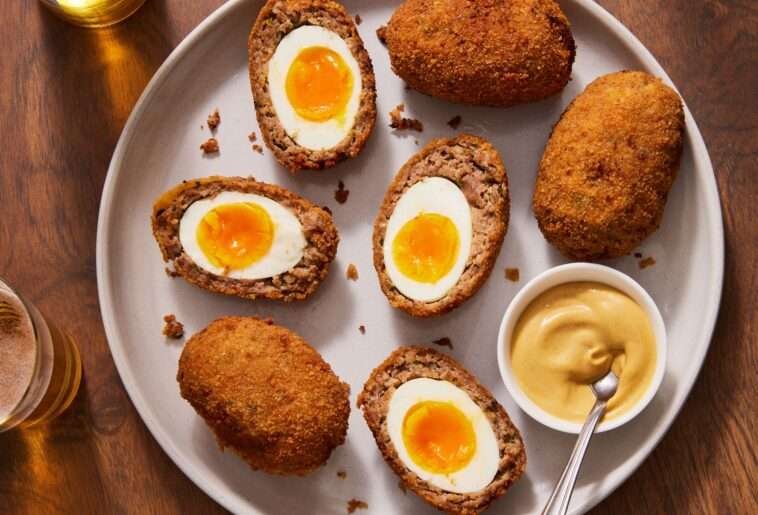A Scotch egg is a baked or fried boiled egg that has been covered in sausage meat and breadcrumbs. A hard-boiled egg is wrapped in sausage meat, deep-fried and served as a Scotch egg. It is frequently consumed as a cold snack at picnics or at pubs. Because they contain an egg, Scotch eggs are also known as vogelnestje (Dutch for “little bird’s nest”) and eierbal (Dutch for “eggball”) in the Netherlands and Belgium. One Scottish recipe from the 1880s refers to them as “birds nests.”
Origin of Scotch Eggs:
There are several origin narratives. According to the Oxford Companion to Food, the name first appears in print in 1809. They did not have a breadcrumb layer at the time, though Isabella Beeton had suggested it by 1861. According to the Oxford Companion to Food, food historian Annette Hope hypothesised in 1987 that Indian koftas, such as the Mughlai dish known as nargisi kofta, may have served as an inspiration.
There are also claims that the product was created at Fortnums. According to Culinary Delights of Yorkshire, they were initially covered in fish paste rather than banger meat and were invented in Whitby, Yorkshire, England, in the 19th century. They allegedly bore the name William J. Scott & Sons after the renowned restaurant that sold them.
Although they were deep-fried in lard, it has also been proposed that they were originally known as “scorch” eggs because they were prepared over an open flame. It is also sometimes said that the term “scotching” originated in the kitchen. However, there is disagreement about what exactly “scotching” entailed; it might have involved adding anchovies or just mincing meat.
The widespread trade in eggs from Scotland in the 19th century, which occasionally required dipping eggs in a lime powder to preserve them, a method that may also be known as “scotching,” adds to the confusion.
How to Make Scotch Eggs
In Britain, Scotch Eggs are fairly common and frequently had with salad or on a picnic. Scotch eggs can be eaten either hot or chilled. Here’s how you can make scotch eggs at home.
Ingredients:
8 eggs
1 lb or 450 g plain sausage meat
2 tbsp chopped mixed herbs (I like chives and thyme)
A pinch of ground mace (see picture below if you are not sure what mace looks like).
1 tbsp English mustard
Splash of milk
½ cup or 50 g flour
1 cup or 100 g panko breadcrumbs, or homemade breadcrumbs
Vegetable oil, to cook
- Put six of the eggs into a pan, cover with cold water and bring to the boil. Turn down the heat and simmer for five minutes, then put straight into a large bowl of iced water for at least 10 minutes.
- Put the meat, herbs, mace and mustard into a bowl, season and mix well with your hands. Divide into six.
- Carefully peel the eggs. Beat the two raw eggs together in a bowl with a splash of milk. Put the flour in a second bowl and season, then tip the breadcrumbs into a third bowl. Arrange in an assembly line.
- Put a square of clingfilm on the worksurface, and flour lightly. Put one of the meatballs in the centre, and flour lightly, then put another square of cling film on top. Roll out the meat until large enough to encase an egg and remove the top sheet of clingfilm.
- To assemble the egg, roll one peeled egg in flour, then put in the centre of the meat. Bring up the sides of the film to encase it, and smooth it into an egg shape with your hands. Dip each egg in flour, then egg, then breadcrumbs, then egg and then breadcrumbs.
Place prepared scotch eggs on a plate ready for cooking.

6. Fill a large pan a third full of vegetable oil, and heat to 325F, 170C (or when a crumb of bread sizzles and turns golden, but does not burn, when dropped in it). Cook the eggs a couple at a time, for seven minutes, until crisp and golden, then drain on kitchen paper before serving.

Baked or Air fried Scotch Eggs:
You can also bake these; we advise doing so at roughly 400°F (200°C) for 20 to 25 minutes, or until they are golden brown. I also tried cooking them in the air fryer for about 25 minutes at 350F/180C. Both approaches are effective, but I always like deep-frying.
The ‘old fashioned’ method of heating up a pan of hot oil and dropping those delicious scotch eggs into it has a certain traditional appeal.
What Do Scotch Egg Taste Like?
If you use fresh eggs of good quality, the yolks will be a gorgeous yellow-orange colour and have an incredible flavour. You get the delicious egg flavour.
When the sausage meat is simply seasoned with salt and pepper and a few other optional spices, it has a great meaty texture (as opposed to the store-bought ones, which have no texture at all) and a nice flavour.
Vegetarian Scotch Eggs:
Shop-bought veggie sausages are used in vegetarian Scotch eggs to create the sausage layer, which is simple to prepare and has a wonderful texture. They are surprisingly simple to make and consist of a bean and chickpea mixture that has been gently seasoned. Boiled potatoes and white rice can also be substituted for beans and chickpeas.
Simply combine several cans of beans, season with ginger, chilli, and coriander, then form into four thin patties. A lightly-baked egg will then be placed in the centre of each patty, and the mixture will be gathered up to form a casing around each egg.
Your vegetarian scotch eggs are ready to fry to golden perfection after a quick dip in flour, egg, and breadcrumbs!

How to Serve Scotch Eggs:
One of these scotch eggs is more than enough to fill your tummy at brunch or lunchtime. Simply sliced in half, you can serve these for a buffet party; make ahead the day before and keep chilled until you’re ready to serve.
Scotch eggs are traditionally served as a snack, say for a picnic, in part because they travel well without risk of getting messy during transport. You may serve these scotch eggs with a variety of things, such as straightforward salad or your favourite chutney like mango or pineapple chutney.
Read More: Can Processed Foods be Harmful to us?





